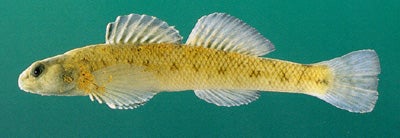JOHNNY DARTER
SCIENTIFIC NAME: Ethostoma nigrum
CHARACTERISTICS: Etheostoma nigrum males typically darken during the breeding season or acquire dark stippling that develops into dark bands along the sides. Females have slight yellowish cast. A frenum is absent on the upper lip and a black bridle extending across the somewhat blunt snout is interrupted above the upper lip, a feature which usually separates E. nigrum from the similar bluntnose darter, E. chlorosonum. Six to seven saddles are present on the back; and seven to 10 blotches are variously developed into W-, V-, or X-shaped markings along the side. A distinct spot is present at the base of the caudal fin and at the front of the spiny dorsal fin. Small spots occur on the spines and rays of both dorsal fins, presenting somewhat of a banding pattern. Krotzer (1990) examines variation and systematics of E. nigrum throughout its range.
ADULT SIZE: 1 to 2.8 in (25 to 70 mm)
DISTRIBUTION: Etheostoma nigrum occurs widely throughout the Mississippi River basin and Great Lakes area. Its southern range extent is reached in Alabama. Collection records of johnny darters are numerous in the Mobile basin, mainly below the Fall Line and usually not extending south beyond the Lime Hills. Known populations in the Tennessee River drainage are limited to collections in the Paint Rock,Bear Creek, and Limestone Creek systems.
HABITAT AND BIOLOGY: The extensive range of the johnny darter indicates its ability to exploit a variety of habitats. Individuals are frequently taken in slow-flowing pools over sand, silt, and mud substrates with detritus or leaf litter and also along the margins of lakes in northern states. The species occurs sparingly in moderate to swift-flowing riffles over gravel and cobble substrates. Spawning occurs from April through June. Winn (1958a, b) observed johnny darters spawning in an inverted position on the undersides of objects. Females deposit eggs singly into clusters of 30 to 200 eggs, with up to 1,150 eggs per nest. The maximum age of this species is four years, and its diet consists of midge larvae, small crustaceans, and mayflies.
ORGINAL DESCRIPTION: Rafinesque described the johnny darter in 1820.
ETYMOLOGY:
Eheostoma means strain mouth, possibly referring to the small mouth.
Nigrum is referring to the dark head and body of breeding males.
The copyrighted information above is from Fishes of Alabama and the Mobile Basin.






